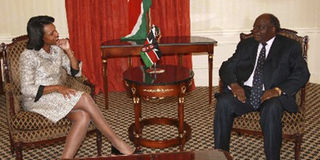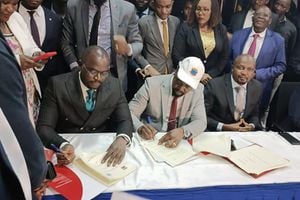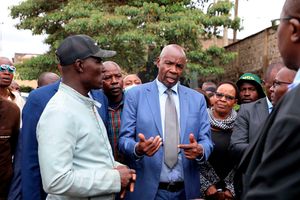Condi on 2007 stalemate: Politicians had Raila and Kibaki on tenterhooks

President Mwai Kibaki talks to then US Secretary of State Condoleezza Rice at his residential hotel in New York City on September 22, 2008. Photo/FILE
When, on November 16, 2004, President George W. Bush nominated Condoleezza Rice, a distinguished political scientist, to be US Secretary of State, he opened a can of worms that agitated the nation for weeks.
There were rumours that the eloquent woman who had overcome great odds to rise to the pinnacle of global power would not make the cut, especially after senators tore into her track record over the war in Iraq.
But, come January 26, 2005, Condi sailed through with a 85-13 backing from the Senate.
The negative votes may not seem that much, but they were the most cast against the nomination of a Secretary of State since 1825.
Condi had sailed through, but she had to prove to her detractors that she had done so on merit.
Two years later, Kenya went to the polls... then to the dogs. From her office in Washington, Condi watched as an ominous cloud of suspicion, tension, and uncertainty hung over the country like a bad omen.
She had burnt her fingers in Baghdad after she criticised the boiling militancy of the nation, equating it with a baseless Islamic ideology, and so she knew she needed to calculate her moves well on East Africa if she were to convincingly advance the diplomatic interests of the United States.
As she pondered her moves, Mr Samuel Kivuitu, the then head of the defunct Electoral Commission of Kenya, called a press conference in Nairobi and announced Mr Mwai Kibaki as the winner of the 2007 General Election.
The country erupted into violence as politicians traded accusations and diatribes.
After weeks of deadly hostilities, dignitaries started knocking on the doors of Nairobi to help quell the violence.
Among those who landed in Nairobi were former Ghanaian President John Kufuor, South African business and political heavyweight Cyril Ramaphosa, former UN secretary general Kofi Annan, Tanzanian President Jakaya Kikwete, and the then US Assistant Secretary of State for African Affairs, Dr Jendayi Frazer.
But it was the arrival of Condi in February 2008 that best illustrated the seriousness with which the international community viewed the events in Kenya.
“The time for a political settlement was yesterday,” Condi said at a news conference at the Muthaiga home of then US Ambassador to Kenya Michael Ranneberger.
Her comments were aimed at the big names inside the Party of National Unity (PNU), who were widely viewed as obstacles to a power-sharing agreement between Mwai Kibaki and the Orange Democratic Movement’s Raila Odinga.
PNU went ballistic, saying that even though it was true that a solution to the crisis was urgent, foreign interventions were not the way to go.
“We will not bow to dictation,” Ms Martha Karua, then minister for Justice and Constitutional Affairs, said after a two-hour meeting between Condi and Kibaki. “We can listen to all our friends. We can engage with them. But the decision ultimately will be ours.”
Condi, the New York Times reported, knew coming in that she would have to tread gingerly, and it seemed that she was bringing carrots, not sticks.
As she was flying from Tanzania to Nairobi over the Serengeti, she insisted that she did not intend to dictate a solution and that she would instead use her meetings to dangle the prospect of additional economic help for Kenya if the rival factions could reach a compromise.
“When Kenya resolves this political conflict,” she said, “they are going to find a very supportive United States in terms of additional work on reconstruction and reconciliation support.”
However, according to her newly published book No Higher Honor: A Memoir of My Years in Washington, it seems Condi was driven into the Kenyan mission as much by a personal quest to assist as by duty.
In the book, Condi says she was motivated to help Annan broker a settlement in Kenya when attending “a dinner that I’ll never forget” in Dar es Salaam hosted by Tanzanian President Kikwete.
On the eve of her visit to Kenya, Condi listened to Tanzanian officials lament their inaction at the time of the Rwanda genocide where one official gave graphic descriptions of the tribal slaughter that took place in 1994.
“Suddenly, no one had much of an appetite,” Ms Rice recalls.
She remembers thinking at the time: “I’d better get on that plane tomorrow and make something happen in Kenya. Once ethnic violence begins, you never know where it’s going to go.”
And indeed the events that followed confirmed her fears of “you never know where it’s going to go” since the violence ended up claiming more than 1,300 lives and leaving almost a million more displaced from their homes, some of whom are still living in camps.
Besides giving details of her emotional urge to hasten the finding of a solution to the political stalemate, Condi has also spared time to describe the two principals and what they stood for.
President Mwai Kibaki is depicted as a “stubborn old man” who “seemed to go into and out of focus” during power-sharing negotiations.
Ms Rice unfavourably contrasts President Kibaki with Prime Minister Raila Odinga, where she writes that Mr Odinga “had many of the characteristics that Kibaki did not (youth, charisma and energy).”
In her talks with Mr Kibaki in February 2008, the president “just kept repeating that he’d won the election,” Condi recalls, adding that he was “losing his train of thought several times.”
“It was then that I realised,” she continues, “that his ‘people’ might be more of a problem than he.
It’s often the case that advisers have as much to lose as the principal, particularly in Kenya, where political power is often accompanied by considerable wealth.”
By “his people”, Condi means a coterie of individuals close to the President who many political commentators have claimed were arm-twisting the Head of State not to yield to the opposition demands of power-sharing.
After reminding Mr Kibaki “of the great promise that everyone had seen in him when he had first been elected,” Condi went to meet with Mr Odinga, who, she says, “was very focused and clear, making the negotiations easier”.
Condoleezza notes that the talks on forming a coalition government were smoothed through “useful back channels” involving Mr Uhuru Kenyatta and Dr Sally Kosgei.
Both politicians — now serving as Deputy Prime Minister and Agriculture minister, respectively — had direct or indirect ties to Stanford University in California, where Condi had been a professor.
Mr Kenyatta’s sister had attended the university along with Dr Jendayi Frazer, Condi’s principal assistant for African policy.
Dr Kosgei was a former student of Condi’s at Stanford. Mr Kenyatta, an ally of Mr Kibaki, and Kosgei, on the side of Mr Odinga, “knew each other, and they knew Jendayi,” Condi writes in the 766-page memoir.
She quotes Dr Frazer as observing: “They are all children of Kenya’s elites and have known each other since grammar school.”
Having helped former UN Secretary General Kofi Annan persuade the antagonists to reach an agreement, Condi says: “I felt very good about the work I’d done in Kenya, most of it without much fanfare.”
A few months before the end of the Bush administration in January 2009, Prime Minister Raila Odinga visited Condoleezza Rice in Washington.
"How are you and the President getting along?” she asked him.
“Not bad,” Raila replied. “I try to respect him for his age. It works okay.”
Apart from explaining her role in the resolution of Kenya’s post-electoral conflict, Ms Rice also discusses other issues pertaining to Kenyan politics.
For instance, she discloses that President George W. Bush delivered a “tough message” to then President Daniel arap Moi during talks in the Oval Office in 2002.
She says Mr Moi had hoped to persuade the United States that Kenya “needed him for stability.”
But Bush told Moi that “when the Constitution says it’s time for elections, you need to step down”.
In an apparent quest to ensure “stability” after his departure, Mr Moi endorsed Mr Uhuru Kenyatta as the Kanu flag bearer for the 2002 General Election, but Mr Kenyatta was resoundingly trounced by the opposition.
The subsequent victory of Mr Kibaki created “great hope that Kenya had turned the corner to a stable democracy,” Condi observes. “We even invited Kibaki to the White House for a rare state visit (in October 2003), made somewhat difficult by his fragile physical condition as a result of a near-fatal accident during his campaign.”
“Nevertheless,” Condi continues, Mr Kibaki “had seemed to be an honest, if hardly inspiring, choice for the post-Moi era.” He did not fulfil those hopes, Condi adds.
Although the 2007 election “was so poorly run that it isn’t clear to this day who really won,” Mr Kibaki was initially determined to continue governing on his own, refusing to share power with Mr Odinga, Ms Rice recounts.
Mr Kibaki, “and particularly the people around him, had turned out to be intolerant of opposition and determined to stay in power,” she says.
The highly publicised state visit that Condoleezza speaks about in her book took place barely a year inside the Kibaki presidency.
But despite the pomp and the media publicity that the visit attracted, many observers have concluded that it yielded very little fruit in terms of development and monetary assistance since President George Bush’s agenda by that time was firmly fixed on his global war against terror.
After coating his speech with pleasantries like the fact that Kenya is “the cradle of civilisation, its traditions and its ancient history inseparable from the story of mankind”, a State Department official confirmed to journalists that “a large portion of the discussions between the two leaders centred on matters of cooperation between our two security forces”.
Kenya’s darkest chapter was written during Mr Michael Ranneberger’s stint at the US embassy in Nairobi.
Having cultivated a firebrand personality of taking issues — political or otherwise — by the horns, the diplomat was a very prominent figure in the media throughout the post-election violence period.
Being the official representative of the US government in the country, Ranneberger was the one who hosted Condi during her visit.
And, as expected, the man who later claimed to have fallen in love with Kenya, had a few words to whisper in the ears of the smiling lady from Washington.
Condi quotes the former ambassador as telling her, soon after her arrival in Nairobi, that the Kenyan people’s yearning for a peaceful resolution of the election dispute was being frustrated by “two bullheaded politicians who can’t see past their own interests”.
“The wananchi did not want war,” Mr Ranneberger is said to have told Condi as they drove towards the Serena Hotel, before handing her a newspaper with a headlined appeal to both Mr Kibaki and Mr Odinga: “Don’t Kill Our Kenyan Democracy.” Ambassador Ranneberger said the headline reflected the view of most Kenyans.
Additional reporting by Mwaura Samora ([email protected])




